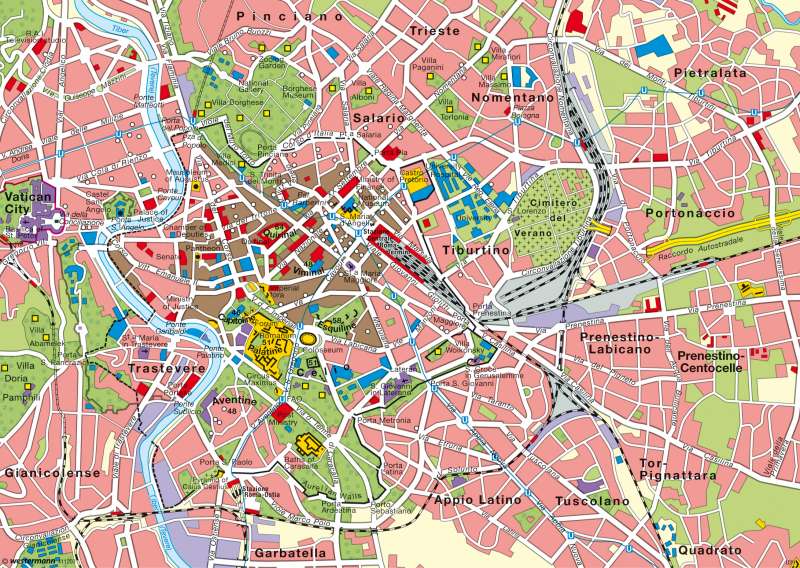Rome — Top destination for city tourism
Southern Europe - Tourist destinations
978-3-14-100790-9 | Page 78 | Ill. 1

Information
Rome is located approximately 20 kilometres from the coast, situated in a plain between the sea and the foothills of the Apennines. According to tradition, the city was founded in 753 BC by Romulus, and built at a higher level on the river Tiber. The famous "seven hills" are the Palatine, Capitoline, Quirinal, Viminal, Esquilino, Celio and Aventino. The city also expanded at a later time and the Tiber separates the Vatican City and Trastevere from the centre.Italian Capital
Rome was not proclaimed the new capital of the Kingdom of Italy until 1871 - after the evacuation of the French occupation troops — in which a rapid growth of the city began a decade earlier. At the time of national unity, there were around 200,000 inhabitants, these numbers have now increased to more than 2.6 million. In 1871, the extremely high population density in today's "centro storico" all but declined over time, but it has had little displacement of residents and high-level tertiary cottage industries.
The current amenities centre is located on the east side of Rome in the new areas which were developed from the19th Century and outside the medieval town centre, which ends approximately at the Aurelian Walls. This area is still mainly residential. Most of the specialised amenities can be found in the form of a concentration of hotels and guesthouses around the terminus train station and around the Villa Borghese. The other high-level tertiary institutions are scattered through out this large city without spatially segregated areas. Part of the city amenities are located far outside the city centre a "centri direnzionali". The city has neither a government nor an administrative district: it can be similarly in order to affirm the economic and cultural institutions.
Religious life is the focus of the Vatican City, which is on a site of less than one square kilometre. It is the seat of the Pope and the centre of the Roman Catholic Church. The Vatican is located outside the ancient and medieval city and outside the current amenities centre. The Vatican City has a long tradition as an independent state. After being a temporary member of the Italian state, it has only been independent since 1929. The current Pope is head of state of the supreme body of the College of Cardinals, which consists of approximately 165 members.
The physical structures of the city of Rome originate from historical roots. Its current purpose is to serve as the capital of Italy and also holds a position as a centre of the Roman Catholic Church. The Roman tradition of ancient Rome is of great ideological significance. It was only through the unification of Italy, that it was possible for Rome to become a permanent capital, although at that time, Rome played a minor role economically and culturally. The current urban development of ancient Rome is still of great importance. The numerous historical monuments and the extensive archaeological zones are major tourist attractions, while the design of the wide streets facilitate public transport and dense traffic volume. However, there has now been a stark effect on many historical monuments from noise and exhaust emissions.
The government, management, cultural life and tourism are currently the dominant economic sectors. Only about 250,000 inhabitants of the city are employed by the Italian state. In addition, employees come to the Vatican, the Food and Agriculture Organisation of the United Nations (FAO) and the numerous corporate headquarters to seek positions with the state administration. Industry, has only secondary importance compared to other cities such as Milan where there are hardly any companies in this sector of national or international importance.
A: E. Sabelberg; Ü: C. Fleming




